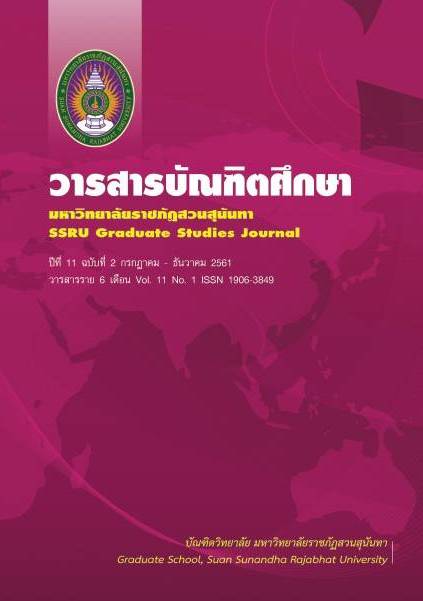The Development of a Model for Student Smoking Behavior Modification : A case study of Phranakhon Rajabhat University
Main Article Content
Abstract
This research aimed to develop and assess the efficiency of a model used to modify student smoking behavior. It employed a mixed research methodology together with a participatory action research. The research was divided into 2 phases: the synthesis of a model for modifying student smoking behavior phase and the development, experiment and efficiency assessment of the model experiment phase. The model was developed based on the Behavioral Change Theory. The research sample consisted of 38 students of Phranakhon Rajabhat University, selected according to the pre-determined criteria. These students had had habitual smoking behaviors and were in the stage of hesitation on behavioral change. After developing the model, ax experiment was conducted for a period of 12 weeks, and it was followed by a follow-up period of 4 weeks. The data were analyzed by descriptive statistics and paired samples t-test. The research results revealed that: 1) the smoking behavior modification model consisted of 12 activities; and 2) the experiment and results and efficiency assessment of the model showed that: 2.1)the average scores on the balance of a decision for smoking behavior modification were higher, with a .01 level of statistical significance (p-value <0.05); 2.2)the average scores on the self-efficacy perception for smoking behavior modification were higher, with a .01 level of statistical significance (p-value <0.05); 2.3) 22 students had changed their smoking habits from having no interest in changing their behavior to starting to change their behavior, accounting for 57.9 percent; 2.4) the average scores on the smoking behavior were lower at a .01 level of statistical significance (p-value <0.05); and 2.5) the satisfaction on the developed smoking behavior modification model was at the highest level (= 4.65).
Article Details
References
บุปผา ศิริรัศมี. (2554). การสำรวจระดับประเทศเรื่อง ผลกระทบจากนโยบายควบคุมการบริโภคยาสูบ International Tobacco Control Policy SurveySoutheast Asia : ITC-SEA (Thailand) การสำรวจระหว่างประเทศ รอบที่ 5 (2554). จดหมายข่าวประชากรและการพัฒนา, 34(3), กุมภาพันธ์-มีนาคม 2556. สถาบันวิจัยและประชากรและสังคม มหาวิทยาลัยมหิดล, ซ, 1-4.
เบญจมาส บุณยะวัน, วันเพ็ญ แก้วปาน, สุรินธร กลัมพากร และนันทวัช สิทธิรักษ์. (2555). ประสิทธิผลของการประยุกต์ใช้ทฤษฎีขั้นตอนการเปลี่ยนแปลงพฤติกรรม. วารสารเกื้อการุณย์, 19(2), กรกฎาคม-ธันวาคม 2555.
ประไพจิตร ชุมแวงวาปี. (2542). ประสิทธิผลของโปรแกรมสุขศึกษาต่อพฤติกรรมการเลิกสูบบุหรี่ของนักศึกษาชาย สถาบันเทคโนโลยีราชมงคล วิทยาเขตขอนแก่น. วิทยานิพนธ์วิทยาศาสตรมหาบัณฑิต สุขศึกษา, บัณฑิตวิทยาลัย มหาวิทยาลัย มหาวิทยาลัยมหิดล.
ปิยมาศ สวนกูล. (2552). การประยุกต์ใช้ทฤษฎีขั้นตอนการเปลี่ยนแปลงพฤติกรรมในการเลิกสูบบุหรี่ ของทหารเกณฑ์ในค่ายวิภาวดีรังสิต จังหวัดสุราษฎ์ธานี. วิทยานิพนธ์วิทยาศาสตรมหาบัณฑิต สุขศึกษาและพฤติกรรมศาสตร์, บัณฑิตวิทยาลัย มหาวิทยาลัยมหิดล.
ภานิสา ระยา, ศรัณญา เบญจกุล, มณฑา เก่งการพานิช, ธราดล เก่งการพานิช, และกรกนก ลัธธนันท์. (2558). ผลของโปรแกรมการเลิกบุหรี่ตามแบบจำลองขั้นตอนการเปลี่ยนแปลงพฤติกรรมของประชาชนในตำบลวังวน อำเภอกันตัง จังหวัดตรัง. วารสารวิทยาลัยพยาบาลบรมราชชนนี กรุงเทพ, 31(2), พฤษภาคม-สิงหาคม 2558.
ภิญญาพัชญ ปลากัดทอง. (2551). การพัฒนารูปแบบการเรียนรูเพื่อเสริมสร้างความสามารถในการเผชิญอุปสรรคของนักเรียนระดับช่วงชั้นที่ 2. ปริญญานิพนธ์การศึกษาดุษฎีบัณฑิต การวิจัยและพัฒนาหลักสูตร, บัณฑิตวิทยาลัย มหาวิทยาลัยศรีนครินทรวิโรฒ.
รังสีจันท์ สุวรรณสทิศกร. (2557). การศึกษาความพึงพอใจของนักศึกษาต่อการจัดการเรียนการสอนรายวิชา LSC 305 การจัดการผู้ขายปัจจัยการผลิตสัมพันธ์. สาขาวิชาการจัดการโลจิสติกส์และโซ่อุปทาน คณะบริหารธุรกิจ มหาวิทยาลัยศรีปทุม.
รัชนา ศานติยานนท์. (2549). พิษภัยบุหรี่ การควบคุมการบริโภคยาสูบ สำหรับบุคลากรและนักศึกษาวิชาชีพสุขภาพ. สำนักงานกองทุนสนับสนุนการสร้างเสริมสุขภาพ (สสส.).
วรรณวิมล รัชนา ศานติยานนท์. (2549). พิษภัยบุหรี่ การควบคุมการบริโภคยาสูบ สำหรับบุคลากรและนักศึกษาวิชาชีพสุขภาพ. สำนักงานกองทุนสนับสนุนการสร้างเสริมสุขภาพ (สสส.).
ศิราณี อิ่มน้ำขาว. (2555). รูปแบบพฤติกรรมการเลิกบุหรี่ที่เข้าบำบัดในคลินิกเลิกบุหรี่ โรงพยาบาลมหาสารคาม. วารสารกองการพยาบาล, 39(3), กันยายน-ธันวาคม 2555.
ศุลีวงศ์ สนสุผล. (2551). การประยุกต์ใช้ทฤษฎีขั้นตอนการเปลี่ยนแปลงพฤติกรรมที่มีต่อการเลิกบุหรี่ของนักศึกษาชายในระดับมัธยมศึกษา. วิทยานิพนธ์สาธารณสุขศาสตรมหาบัณฑิต การพัฒนาชุมชน, มหาวิทยาลัยราชภัฏนครราชสีมา.
สำนักงานสถิติพยากรณ์ สำนักงานสถิติแห่งชาติ. (2557). การสำรวจพฤติกรรมการสูบบุหรี่และการดื่มสุราของประชากร พ.ศ. 2557. สำนักงานสถิติแห่งชาติ กระทรวงเทคโนโลยีสื่อสารสนเทศและการสื่อสาร, i, 3.
Kanitta Bundhamcharoen. (2009). Economic Burden From Smoking Related Diseases in Thailand in 2009. International Health Policy Program (IHPP), Ministry of Public Health. Nonthaburi 11000 Thailand, 8.
Prochaska, J.O., Norcross, J.C., Diclemente, C.C. (2006). Changing for Good. Arevolutionary six-stage program for overcoming bad habits and moving your life positively forward. New York: Harper Collins Publishers
Prochaska, J.O., Redding, C.A., & Evers, K.E. (2008). The Transtheoretical model and stages of change.In Glanz, K., Rimer, B., &Viswanath, K. (4th .ed). Health behavior and health education: Theory, Research and Practice. San Francisco: Jossey –Bass, 97-122.


